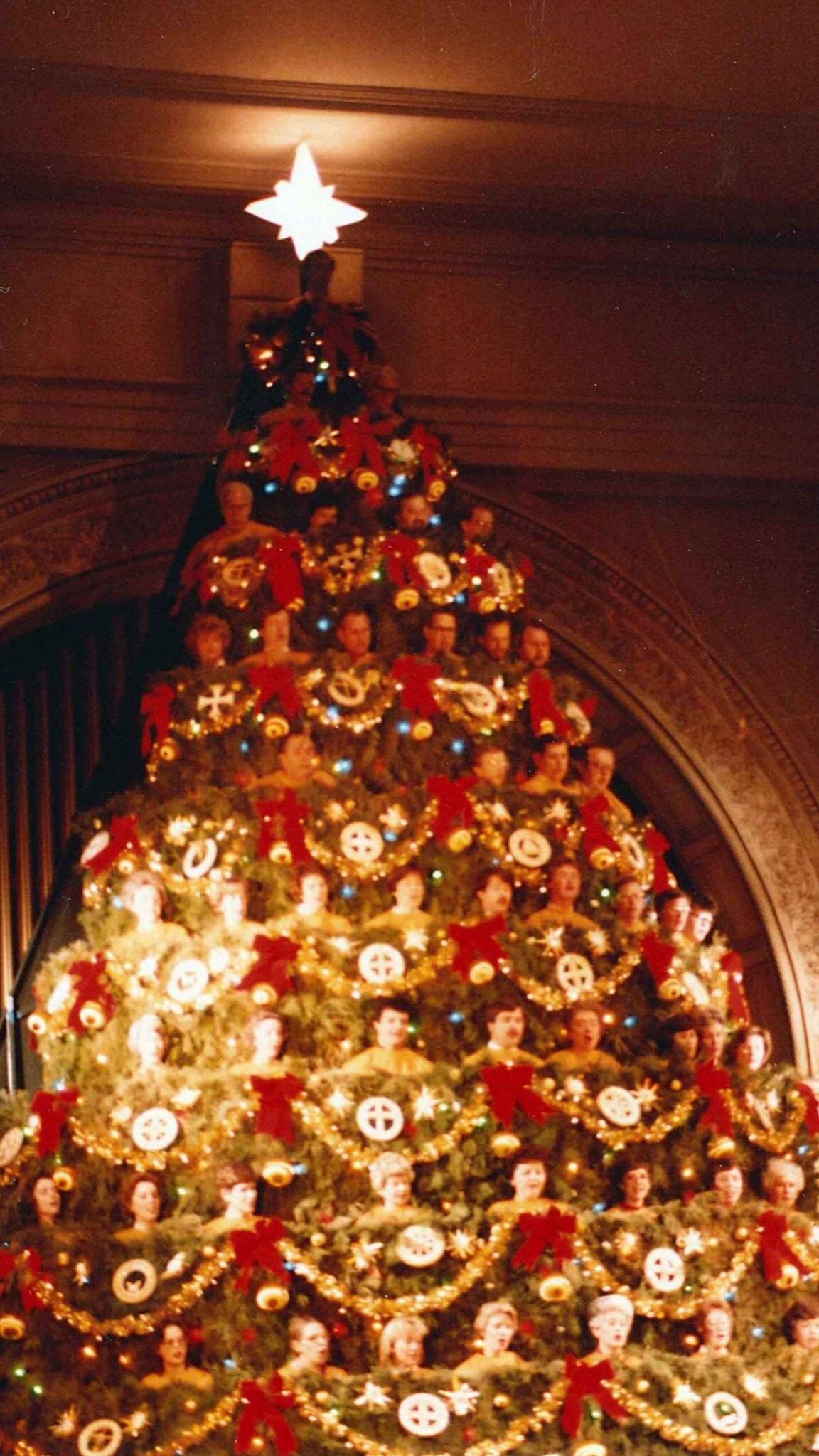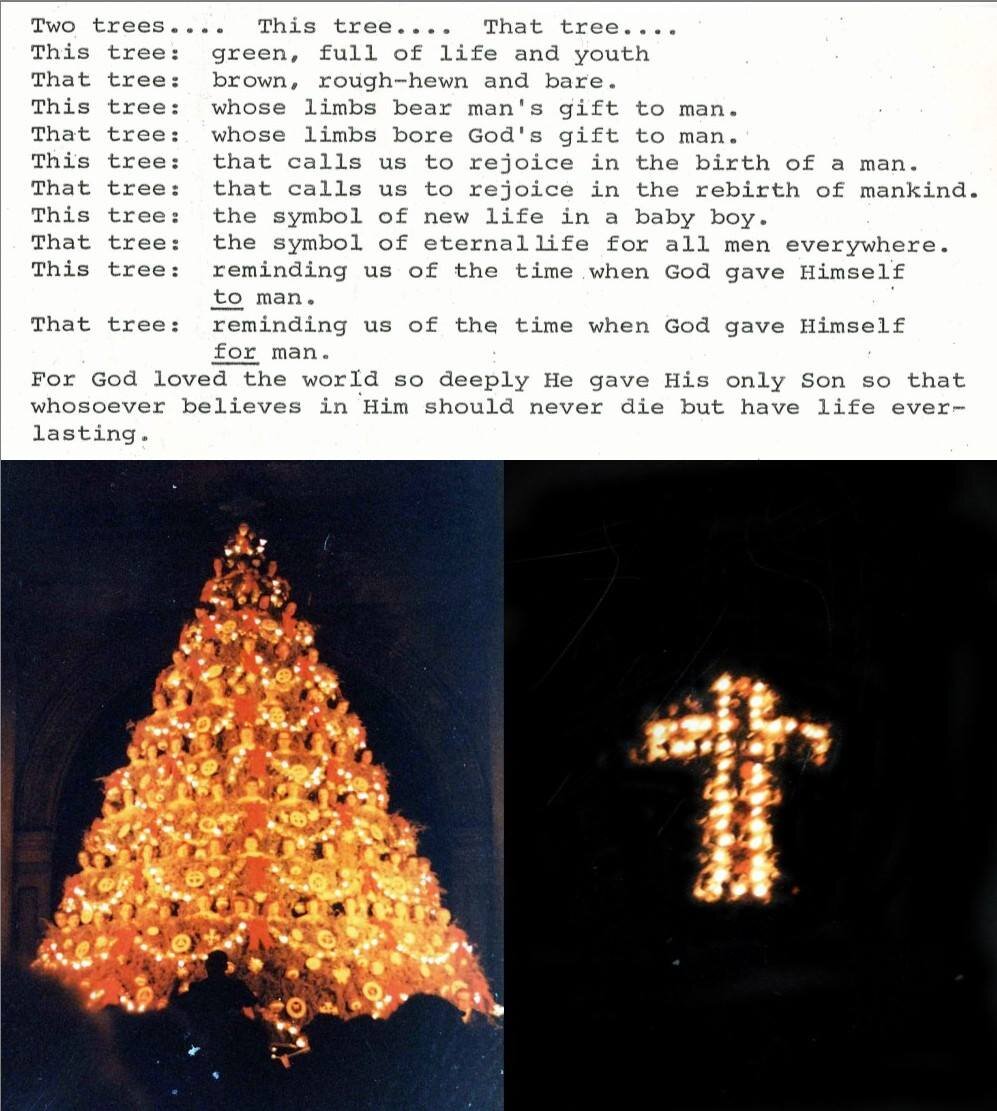The Christmas tree and the cross
When I was a kid, my church did a Living Christmas Tree program each Christmas season. The event was very much a product of 1980s church culture. It featured a massive steel-framed Christmas tree that rose from the base of the stage to inches from the high ceiling. The tree was constructed to support ascending rows of choir members who stood behind the tree's greenery with only their heads and shoulders exposed. The large choir would perform from the tree, while drama skits and small musical ensembles would perform on stages to the left and right of the tree. The event featured a full orchestra and the spectacle of lights on the tree. I loved it and looked forward to it each year. Over the years, there were common themes that were used year after year. One of these was a narration that made a distinction between the Christmas tree and the cross. With only the Christmas lights on the massive Christmas tree illuminated, the narration would speak of the traditions and significance of the Christmas tree. After speaking of "this tree," the narrator would then turn his attention to "that tree." At that moment, the sparkling Christmas lights would fade out, and the shape of a cross formed by simple white lights would appear. It was simple but dramatic and very effective. All these years later, that narration is what stands out in my memory above all the other more grandiose moments of the show.
Years later, when, as a pastor, I had the responsibility to plan Christmas worship services, I desired to share with my church the dramatic contrast between the Christmas tree and the cross tree. So, working from memory of what I experienced as a child, I wrote the following text and have read it many times over the years at Christmas Eve services (since then, my home church has posted photos of this event that include the “Two trees… This tree… That tree…” script on Facebook. See the photo). As we prepare again this year for Christmas day, I pray that "The Christmas Tree and the Cross" will be a blessing to you.
The Christmas Tree and the Cross
The Christmas tree has become the ubiquitous symbol of Christmas. On its branches, we hang ornaments of beauty, ornaments of remembrance, and ornaments of declaration. For many of us, our Christmas trees are the bearers of some of our greatest treasures. Styrofoam adorned with pipe cleaners created by a child who’s now an adult, figurines purchased in far-off places that tell stories of adventures had, or even old and faded ones that once were the treasured ornaments of one who now celebrates in the presence of the Lord. It is, whether adorned with priceless treasures or costly adornments, a part of our celebration of Christmas. On Christmas morning, this tree will be the centerpiece of our excitement as we rip the paper and open the boxes of our gifts to one another.
The Christmas tree is one that summons thoughts of joy and happiness and all the goodness this season brings. Yet, there is another tree that is even greater than this one. Upon it, we do not hang ornaments or decorations, yet it is even more significant to the Christmas story than the Christmas tree. Upon it, there are no Christmas lights yet because of it, light altogether was hidden from the earth for most of a day, and because of it, the light of the world penetrated men’s hearts. Though the Christmas tree is the great emblem of our celebration, it is because of the cross tree that we have hope.
Under the Christmas tree, we place our gifts to one another. It marks the spot where families will gather to enjoy the jolly and celebration of Christmas morn. Around it, we will sit among the sea of wrapping paper, admiring our gifts and thanking the gift-givers. Yet, on the cross, the greatest gift of all eternity was offered. For it marks the spot where Christ, the promised messiah, the perfect lamb of God, the righteous branch of David, the one who Isaiah called Wonderful Counselor, Mighty God, eternal Father, and the Prince of Peace, offered his blameless life as the propitiation for our sin. For Christ “had to be made like his brothers in every respect, so that he might become a merciful and faithful high priest in the service of God, to make propitiation for the sins of the people.” (Hebrews 2:17)
Around the Christmas tree, we gather to enjoy the warm relationships of our kin and those whom we love. It adorns our churches and homes and is one of the most prolific symbols of Christmas. It often marks the place where we will celebrate Christmas Day. Yet around the cross gathered witnesses, both sympathetic and hostile, to unknowingly watch the most extravagant price ever paid on our behalf so that the broken relationship between God and man might be restored. “For Christ also suffered once for sins, the righteous for the unrighteous, that he might bring us to God, being put to death in the flesh but made alive in the spirit” (1 Peter 3:18).
The Christmas tree points toward heaven. We reserve the top for the grandest ornament. These ornaments often are images of angels, the messengers of God, or a star, which God used to lead some of the first worshipers to the feet of King Jesus. The cross does not point to heaven but rather is the way by which all those who shall know the freedom from sin must pass. For Jesus said: “I am the way, and the truth, and the life. No one comes to the Father except through me.” (John 14:6) And “If anyone would come after me, let him deny himself and take up his cross daily and follow me. For whoever would save his life will lose it, but whoever loses his life for my sake will save it.” (Luke 9:23-24)
On the Christmas tree, we place hundreds of tiny lights. Displayed in prominent places, this light illuminates its surroundings with a delicate glow. With this light, we are enabled to see, and the darkness retreats. Yet, on the cross hung the light of the world who overcame the darkness. For Christ, Jesus said: “I am the light of the world. Whoever follows me will not walk in darkness, but will have the light of life.” (John 8:12). It is because of this great gift of light we worship in joyful celebration. For the prophet Isaiah would write about the promised messiah: “The people who walked in darkness have seen a great light; those who dwelt in a land of deep darkness, on them has light shone.” (Isaiah 9:2)
The law of light demands that wherever light shines, darkness must flee. Through a virgin’s womb, in the midst of the most humble of surroundings of a stable, came God himself, the author and creator of light. And in so doing, the light of the world confronted the darkness. A confrontation that would crescendo at the cross. Through this mighty confrontation, the light overcame the darkness. Jesus said, “I have come into the world as light, so that whoever believes in me may not remain in darkness.” (John 12:46)
Therefore, let us be the light of the gospel and proclaim to one another and the world that the Messiah has come. Joy to the world! The people who once were enslaved in darkness have seen a great light!
Joy to the world, the Lord is come!
Let earth receive her King;
let ev’ry heart prepare him room
and heav’n and nature sing,
and heav’n and nature sing,
and heav’n, and heav’n and nature sing.
Joy to the earth, the Savior reigns!
Let men their songs employ,
while fields and floods, rocks, hills, and plains,
repeat the sounding joy,
repeat the sounding joy,
repeat, repeat the sounding joy.
No more let sins and sorrows grow
nor thorns infest the ground;
he comes to make his blessings flow
far as the curse is found,
far as the curse is found,
far as, far as the curse is found.
He rules the world with truth and grace
and makes the nations prove
the glories of his righteousness
and wonders of his love,
and wonders of his love,
and wonders, wonders of his love.












Last week, the Southern Baptist Convention held its Annual Meeting. Gathering in New Orleans, LA, there were nearly 19,000 in attendance. Of these, 12,737 were registered messengers (messengers are similar to delegates) from 4,423 churches. During the two days of meetings, the messengers worked through a packed schedule that included changes to the doctrinal statement of the Convention and a constitutional amendment, among many other things. Southern Baptists are unique in that we have our debates over critical issues in public with the opportunity of any registered messengers to speak. This does not always make for flattering soundbites in the news and sometimes leads outside observers to think that we are contentious and in constant conflict. For those who attend the meetings and participate in the decisions, even in greatly debated issues, we generally depart the annual meeting more encouraged in the work and cooperation of the SBC. Below are some of the more significant decisions of the messengers to this year’s annual meeting.